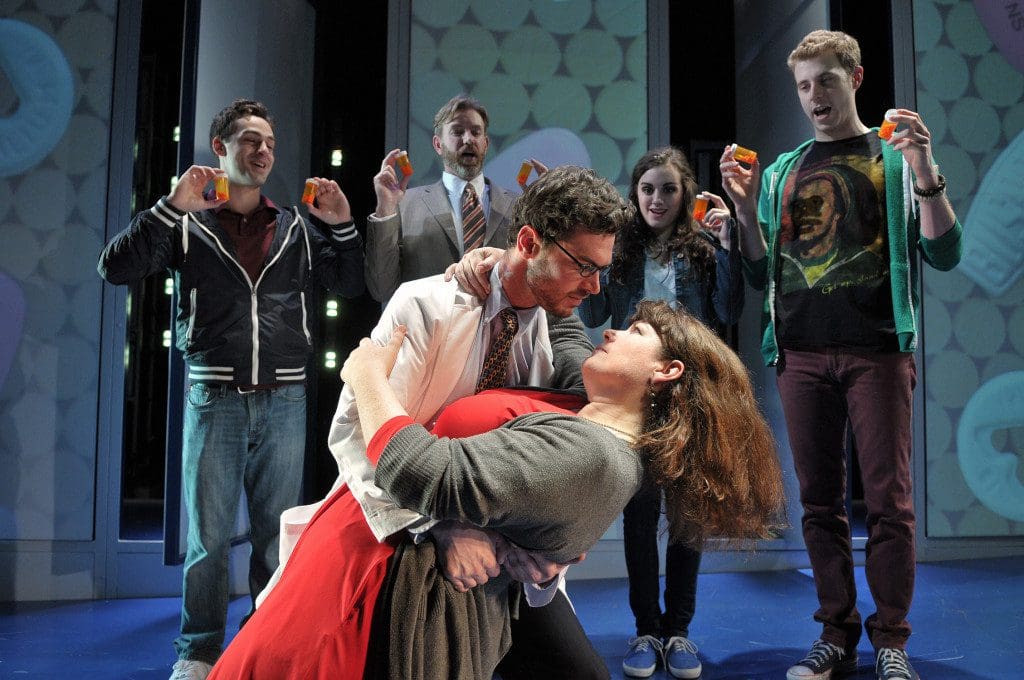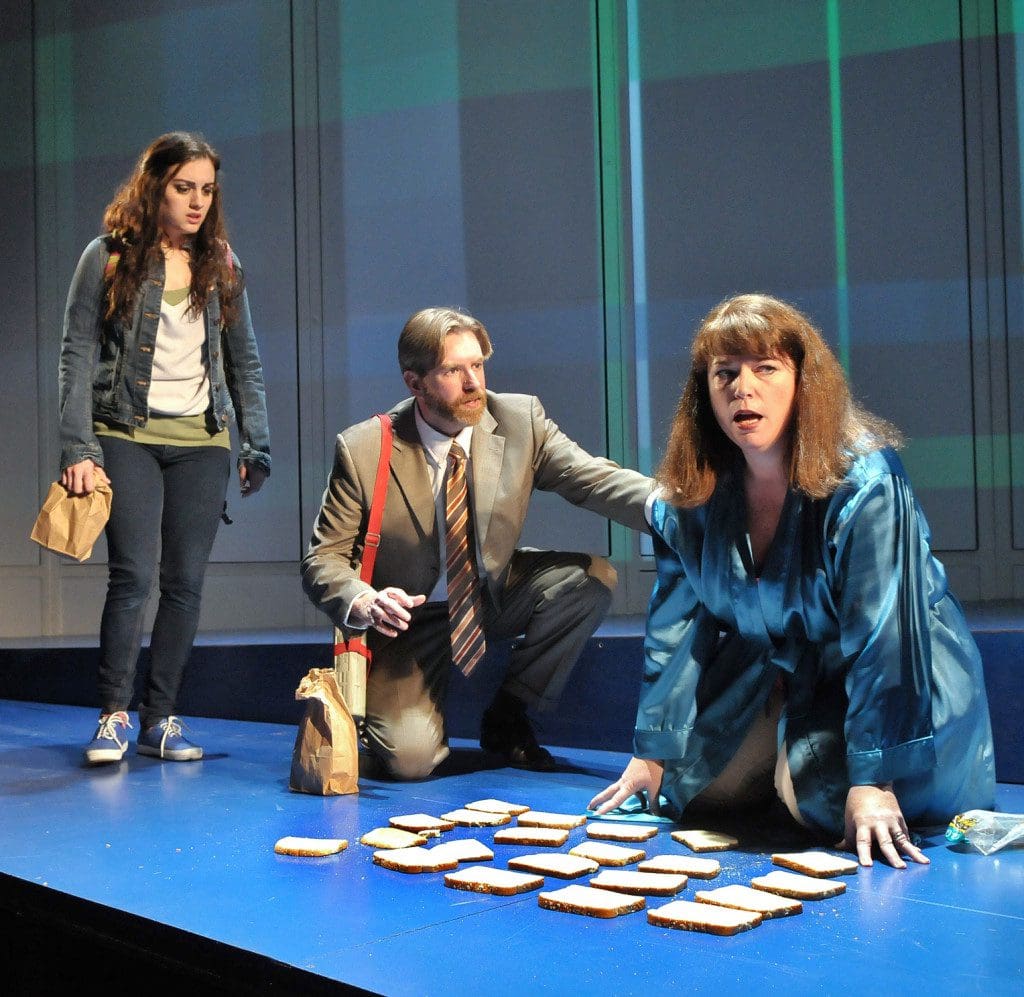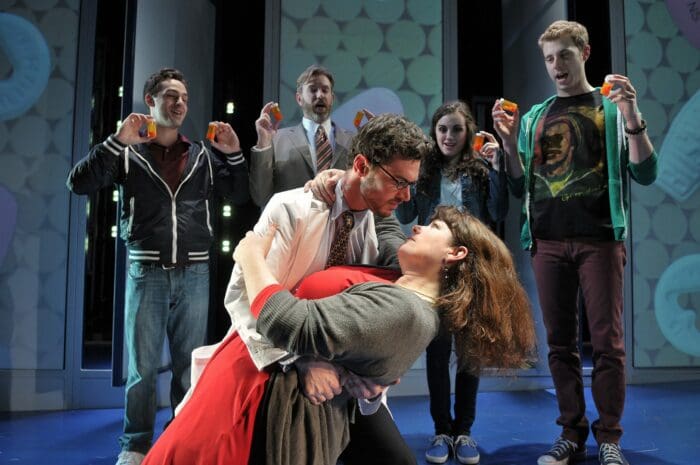
SpeakEasy Stage assembled an amazing 2011-2012 season; kudos to Paul Daigneault, Producing Artistic Director, and the rest of the SpeakEasy crew.
The highlight of their season for me was their current production of Next to Normal, a show that swept Broadway by storm a few years ago and continues to reverberate through the theatre scene. With a rock-lite score by Tom Kitt and a smart book & lyrics by Brian Yorkey, Next to Normal is a hit among the younger generations. Whoever thinks these songs are just meant for the stage hasn’t listened to the whole score, or seriously needs to listen to some of the other trash on the radio. Daigneault directs this stunning production at the Boston Center for the Arts Calderwood Pavilion in their Roberts Theatre, a surprising but extremely effective choice. One of Daigneault’s greatest strengths (and there are many) in this production is his seamless flow of the story through multiple locations. The scenic design by Eric Levenson is superb and impressive, especially the multiple uses for the opening panels of the back wall. I also really liked the lighting design by Jeff Adelberg, a subtle infusion of color and mood that really complements Levenson’s set. While I wasn’t in love with some of the costume choices by Tyler Kinney for the six characters (the father’s costumes looked like something out of Father Knows Best and the boyfriend looked like they were trying too hard to make him look younger than he was), I like that they use color to their benefit in many scenes. It goes without mentioning that Nicholas James Connell’s music direction is spot-on; the blending of his talented cast is truly remarkable.
But the real highlight of this production is the actors. Daigneault cast some real gems and Next to Normal showcases their extraordinary talents. At the heart of the story is a “normal” family and we’re treated to “Just Another Day” at the opening of this anything but normal musical. Daigneault navigates the actors through their morning routine in a vibrant way and keeps the song snappy and sharp, essential for the chilling conclusion of the song where the audience realizes for the first time that something is so terribly wrong. This is a musical about mental illness and its many effects on those we love. And while it’s clear our focus is on Diana, the mother of this troubled family, wonderfully played by Kerry A. Dowling, I couldn’t help but focus on how others in the family teeter on the brink of emotional exhaustion and collapse. Dowling is stunning and her nuanced performance is thoroughly appreciated in a role which can easily lead to broad characterizations and stereotypes. Dowling is also a master at forging relationships with her scene partners, most notably with Michael Tacconi, who plays Gabe, her eighteen-year-old son. Their scenes are wonderfully sincere and moving, understated and rich.
Thankfully so, because their mother-son relationship is pivotal to most of the plot. Because you see, Gabe is a figment of Diana’s very active imagination, though I would argue he inhabits his father and sister’s thoughts too. Tacconi is charming and winning as Gabe, and I’m not surprised Diana doesn’t want to give up her memories and imagination of him. He has a perfect voice for Gabe and though he seemed quite tired (I saw the show on Sunday of opening weekend), he rarely lets it show in his demanding vocals. My only complaint (and it’s a big one, given my unreasonable and silly expectations) is the song “I’m Alive.” I think Tacconi misses the mark on the song’s purpose, but I had to forgive and forget because he is mesmerizing before and after the song. While I believe the song is pivotal to Gabe as a character and his arc in the story, Tacconi has so many beautiful moments in the rest of the show that I can’t dwell on my own preconceived notions of the character.

Equally impressive vocally is Dan, Diana’s husband, played with emotional fortitude by Christopher Chew. While stylistically amazing in a difficult score, I didn’t like something about the character. Maybe I missed a crucial moment, but I couldn’t emphasize with Chew’s portrayal of the suffering husband and father. I also (irrationally) hated the beard. He seemed a little reserved, a little unaccommodating, a little too eager for quick fixes. His “I’ve Been” is particularly strong and moving, but I also felt like his voice was from another generation of musical theatre that didn’t quite match with the rest of the cast. I would love to see him in a more traditional musical that better showcases his strong bari-tenor voice.
Henry, Natalie’s boyfriend, played with boyish charm and care by Michael Levesque, is cleverly portrayed. I loved the many moments that Levesque created with a soft smile or turn of his head. I think the character is pretty lackluster compared with some of the other giant roles in the production, but Levesque never lets that deter him from being a formidable presence onstage. Indeed, if he wasn’t so warm and charming I would have to rant again about how Boston theatre companies cast roles well beyond the actor’s capable age range. Fortunately, Levesque matches perfectly with Natalie; he understands his character’s motivations and goals, but more importantly, he knows his character’s underlying purpose in the narrative structure by the playwright. This level of acting cannot be taught and I appreciated someone taking the initiative to transform the role into a memorable one.
Of course, the real memorable star of this show is Natalie, Diana and Dan’s daughter, smartly played and beautifully acted by Sarah Drake. From her first entrance in a caffeine-induced haze to her transformation into a pill-popping narcotic to her evolution as an adjusted young woman, Drake takes the audience on an emotional journey. She makes Next to Normal her story, a quality that I always respect in any actor. Some people may fault her for being too strong of an actress because they see this story as Diana’s struggle, but I couldn’t be happier. To tell the story from the perspective of someone who worries about her own emotional stability while watching her mother suffer is so dynamically rich that I was brought to tears on numerous occasions during her scenes. Her singing is remarkably strong for someone so young and she sings with exceptional emotions, especially during “Superboy and the Invisible Girl.” Her scenes with Henry are particularly strong as well, establishing their chemistry and dependency on one another; her strength as a character helps develop why Henry puts up with her emotional baggage (something that Dowling also employs with equal aptitude in Diana’s scenes with Dan). The strength of the production rests largely on the fact that Dowling and Drake are such powerhouse performers and their stories and struggles mirror each other perfectly.
SpeakEasy succeeded again in wowing me with their impressive, emotional interpretation of Next to Normal. While I missed the original on Broadway, I have difficulty believing that Alice Ripley did a better job at portraying the suffering Diana or that Jennifer Damiano acted with more pathos. Don’t miss this sure-to-be-award-winning production running until April 15.

